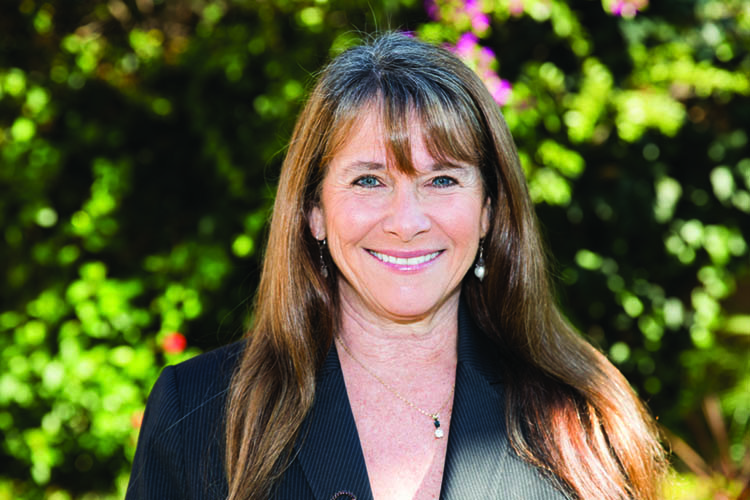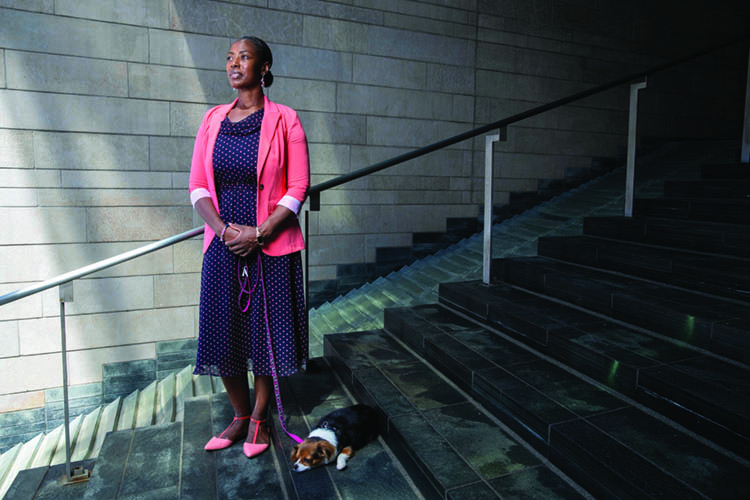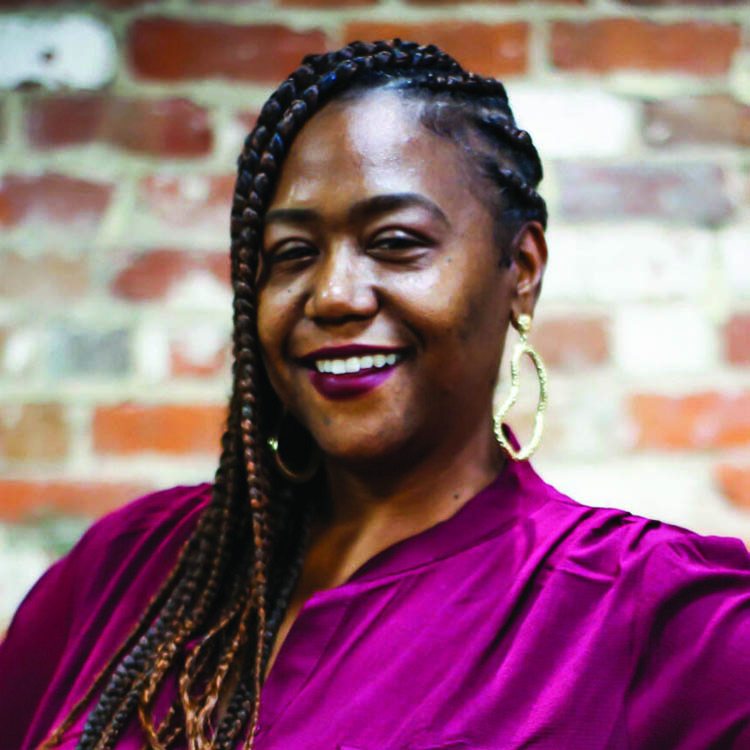Prosecutors are working toward the release of the longest-serving inmates

Photo Illustration by Sara Wadford/ABA Journal
Becky Feldman was in her first year at the University of Baltimore School of Law in 2000 when two men killed her younger brother.
Leonard “Lenny” Kling Jr., who was 22 when he was murdered, knew one of the men from the Baltimore County Detention Center, where he spent several months for violating the terms of his probation after his conviction for marijuana distribution. After his release, Kling agreed to purchase a large amount of marijuana from his killer, not realizing it was a setup until it was too late.

Becky Feldman: “We have this aging population who are just sitting there being warehoused, who are no longer threats.” Photo by David Hills Photography/ABA Journal.
The man and his accomplice met Kling in Baltimore, shot him as he sat in his car on a residential street and rifled through his pockets for money. They were eventually arrested and pleaded guilty to their roles in his murder.
“The closure people get from having someone held accountable is life-changing,” Feldman says. “I felt like I could breathe again, like I could live again.”
Feldman’s life soon changed in other ways. The Baltimore County native thought she might work for a nonprofit organization after law school, but Frank Rangoussis, the prosecutor who handled her brother’s case, pushed her to pursue criminal law.
She took an internship with the Baltimore County State’s Attorney Office so she could learn how to help victims and their families in the same way Rangoussis helped hers. She liked being in the courtroom, and after graduating in 2002, clerked for Baltimore County Circuit Court Judge Christian Kahl for two years.
Sitting with the judge every day and hearing his criminal matters, Feldman discovered she often felt empathy for not only the victims but also for many of the defendants.
She saw her brother in those who made wrong choices and understood that others grappled with addiction, poverty or abuse.
Feldman changed course and joined the Maryland Office of the Public Defender in 2004. She later became the chief of the Post Conviction Defenders Division and then the deputy public defender, and she mostly represented older inmates who had been sentenced to life in prison. Today, she calls it the best decision she ever made.
“When you meet these guys, after all these years in prison, they’re normal, kind and generous,” Feldman says. “I think there is a big disconnect when people say they should stay in jail forever, they took a life. I totally understand because I was one of those people, but it’s harder to think that when you see the humanity behind them.”
Building momentum
In another twist, after 16 years as a public defender, Feldman joined the Office of the State’s Attorney for Baltimore City in December—to, as she says, “do the same type of work but on the other side of the fence.”
Feldman’s work has focused on remediating what she considers excessive sentences, but she also believes those who are guilty should serve an appropriate amount of time behind bars. In 2013, she started a petition to prevent one of the men who killed her brother from getting released early, on parole, after he served 12 years of a 22-year sentence.
As the chief of the Sentencing Review Unit, Feldman examines the cases of men and women who have been incarcerated for decades and then determines whether the office would support their release. She began by prioritizing inmates who were either 60 and older or committed a crime when they were 17 or younger.

Miriam Krinsky heads Fair and Just Prosecution, a network of elected prosecutors working to reform the criminal justice system. Photo courtesy of Miriam Krinsky.
In all those cases, inmates must have spent at least 25 years in prison on a life sentence and have a documented medical condition that puts them at higher risk of contracting COVID-19.
“Our state has a mass incarceration problem caused by lengthy and excessive sentences, which are disproportionately imposed on people of color,” Baltimore State’s Attorney Marilyn Mosby said when she announced the creation of the unit. Citing data from the Maryland Department of Public Safety and Correctional Services, she noted nearly 80% of the 2,200 individuals serving life sentences in the state were Black.
Mosby’s office joined others—including the King County Prosecuting Attorney’s Office in Seattle and the Los Angeles County District Attorney’s Office—that have established sentence review units. The Brooklyn District Attorney’s Office in New York City, the San Francisco District Attorney’s Office and the Philadelphia District Attorney’s Office also focus on resentencing.
Historically, most prosecutors haven’t felt responsible for examining cases closed by their predecessors to determine whether everyone’s punishments fit their crimes. The prosecutors in these offices, however, are pushing their field to adopt changes to address mass incarceration and sentencing disparities in the criminal justice system. (See “Change Agents,” June 2019, page 40).
U.S. federal and state prison populations rose dramatically—from 200,000 inmates in 1973 to 1.5 million in 2009—because of tough-on-crime policy decisions such as mandatory sentencing and longer sentences for violent and repeat offenders, according to a 2014 National Research Council report. As of 2019, nearly 1.4 million people were still serving time in prison in the United States.
By 2020, more than 200,000 people were serving life sentences in U.S. prisons—more people than were serving any sentence in prison in 1970. The Sentencing Project’s May report also shows that nearly half of that population was Black and nearly one-third was 55 or older.
“We’ve reached a point where there is much broader consensus that we put too many people behind bars for too little,” says Amy Fettig, a human rights lawyer and the executive director of the Sentencing Project, a Washington, D.C.-based research and advocacy center. “The piece that needs more recognition is that not only do we put too many people behind bars, but we put them there for too long.”
Fair and Just Prosecution is a national network of elected prosecutors that is committed to a criminal justice system “grounded in fairness, equity, compassion and fiscal responsibility.” After initially focusing on conviction integrity review, it brought leaders from around the country to Yale University in October 2019 to discuss revisiting lengthy sentences.
In April, Fair and Just Prosecution also convened more than 60 prosecutors and law enforcement officials to issue a joint statement advocating for measures that could facilitate the review and reduction of extreme sentences. Among their recommendations: Prosecutors’ offices should create sentencing review units.
“When we gathered in 2019, there were very limited on-the-ground models of sentencing review processes or units,” says Miriam Krinsky, the executive director of Fair and Just Prosecution, who served as a federal prosecutor for 15 years. “At the time, Seattle had been doing it for a couple of years under Dan Satterberg, and California had passed legislative reform.
“But since that time, there has been a dramatic increase in momentum around the issue and in elected prosecutors who are standing behind it and creating a broader notion of looking at both unjust past convictions and also unjust past sentences.”
‘In the interest of justice’
Carla Lee joined Satterberg in the King County Prosecuting Attorney’s Office in 2013 and took over its clemency work when he later appointed her deputy chief of staff.
She focused on reviewing the cases of people who were incarcerated because of Washington’s 1993 three-strikes law, which requires courts to consider someone a “persistent offender” and sentence him or her to life in prison without parole if convicted on three separate occasions of serious felonies.

Carla Lee heads the Sentence Review Unit for the the King County Prosecuting Attorney’s Office in Seattle. Photo by Yosef Kalinko/ABA Journal.
“The clemency process was an executive process that was too long, too cumbersome,” Lee says. “We started saying, ‘OK, there are some cases where we are going to use clemency for getting early relief, and there are other cases where we’re just going to ask the court to resentence this person in the interest of justice.’”
Since courts typically revisit sentences after legal or constitutional errors are made at trial, a judge in July 2019 questioned the prosecutors’ authority to request a new sentence for someone incarcerated under the three-strikes law. Lee says they decided then to advocate for legislation to aid their efforts.
The Washington state legislature passed a bill the following March that gives elected prosecutors discretion to petition the court to resentence individuals whose original sentences no longer advance the interest of justice. It didn’t provide criteria, which allows offices to set their own sentence modification guidelines.
In her office’s Sentence Review Unit, Lee continues to prioritize three-strikes cases because of a state law passed in April that requires prosecutors to seek resentencing for any individual who was deemed a persistent offender based on a conviction for second-degree robbery. A 2019 law made the offense, which is generally defined as a robbery without a deadly weapon or harm to others, no longer a three-strikes offense.
Russell Harvey committed a string of robberies at several Seattle grocery and clothing stores and was sentenced to life in prison in 1998. In June, the now 60-year-old became one of the first men Lee helped resentence under the law.
The judge in Harvey’s case gave him a new sentence of seven years with time served after he shared that a character-building course helped him turn his life around in prison.
“That’s when he started to see that he had more to offer society,” Lee says. “It was a very powerful story and a very powerful moment for us in court. But those are the kind of second chances that these types of policies create for people.”
In addition to about 30 three-strikes cases, Lee is prioritizing other groups, including individuals who were under the age of 25 at the time they committed a nonhomicide crime. In many cases, she says, they received much longer sentences than they would have for the same crimes today.
Lee has also connected with Fair and Just Prosecution as well as prosecutors in Baltimore and Los Angeles to continue the dialogue on how they can use their authority to revisit old cases.
“We started conversations with them and tried to see how as prosecutors we could broaden our work in this area, how we could start to spread this nationally,” says Lee, who is assisted by one paralegal. “So those three—LA, us in King County and Baltimore—we’re on the cutting edge of really pushing this approach.”
Focus on public safety
In January, Diana Teran brought more than 30 years of experience to the Los Angeles County District Attorney’s Office, where she previously had spent about a decade as a prosecutor.
As a special adviser to the newly elected George Gascon, she helped create his office’s Resentencing Unit. Gascon campaigned on ending excessive sentences, and in April he asked eight attorneys to begin reviewing cases where people received punishments that no longer seemed appropriate under current law or outdated policies.
Similar to Washington, a California law gives prosecutors discretion to review cases and recommend to the court a reduction of a defendant’s sentence. Prior to the law’s passage in 2018, only the state’s Department of Corrections and Rehabilitation or Board of Parole Hearings could make these recommendations.

Amy Fettig: “We’ve reached a point where there is much broader consensus that we put too many people behind bars for too little.” Photo courtesy of Amy Fettig.
While as many as 20,000 cases could be eligible, Teran says the unit is currently reviewing about 450 in two categories. The first involves adults who are 50 and older, received sentences of 20 years or more for a nonserious or nonviolent felony and served at least 10 years. They can’t have a prior conviction for a “super strike” offense such as murder or be a sex offender registrant.
The second category includes minors who were tried as adults. To qualify, they must have been sentenced for a crime they committed at ages 14 or 15 and already served 10 years. They also can’t be in prison for murder or a sex offender registrant.
“There has been quite a number of published studies that show that incarcerating individuals for the length of time that we have been incarcerating them can be counterproductive,” Teran says. “Not just in terms of rehabilitation, but counterproductive in terms of creating more victims in the long run by doing this.”
Teran’s office cites a 2018 report by The Sentencing Project that shows while people’s involvement in most crimes begins declining by their early-to-mid-20s, the median age range in federal prison is 36 to 40. As a result, the report says, each year of incarceration likely leads to diminishing returns for public safety.
Even if the Resentencing Unit reviews a case, Teran says it doesn’t mean it will recommend resentencing. Attorneys consider several factors—such as rehabilitation, disciplinary history and reentry plans—before making their decision.
They also notify crime victims and invite them to speak during resentencing proceedings. Teran says even after they explain the reasons for their recommendation, some victims don’t want the person who harmed them to be released from prison.
Tania Owen wanted the death penalty for the man who murdered her husband, but Gascon announced that his office would no longer pursue capital sentences. Owen says her family still got justice after the killer pleaded guilty to first-degree murder and in May received a sentence of life in prison without the possibility of parole.
The 27-year-old had been arrested multiple times, sent to prison twice and was out on parole in October 2016 when he shot and killed Steve Owen, a Los Angeles County sheriff’s sergeant who had served nearly 30 years with the department.
“Some of these guys … are monsters that have no business being out in society with the rest of us,” says Owen, a retired Los Angeles County sheriff’s deputy who met her husband on the job.
Owen joined other crime victims in an effort to recall Gascon, whose directives related to sentencing and the death penalty have “worked more for the criminal than for the victims,” she says.
As the campaign’s co-chair, Owen contends that the group is not against reforming the system—if it makes life better for everyone.
“This has nothing to do with politics, it has nothing to do with race,” Owen says. “It has nothing to do with anything other than standing up for victims and holding criminals accountable for their actions.”
Tinisch Hollins sees the issue from a different perspective. As the executive director of Californians for Safety and Justice, a flagship program of Alliance for Safety and Justice, she aims to replace incarceration with other public safety initiatives, such as community health and crime prevention.

Tinisch Hollins: “If what’s at the core of the crimes that have been committed is unaddressed trauma, mental illness, addiction and poverty, longer sentencing is not going to prevent more crimes from happening.” Photo courtesy of Californians for Safety and Justice.
Hollins, a San Francisco native who lost two brothers to gun violence—one in 2013 and one in 2017—has worked for more than two decades to bring crime survivors into conversations about criminal justice reforms. She says the last thing most of them want is for anyone else to become a victim.
“We are taking individuals and giving them lifelong sentences for crimes that could have been prevented if the right interventions were in place, and it would have resulted in a safer community for everyone,” Hollins says. “If what’s at the core of the crimes that have been committed is unaddressed trauma, mental illness, addiction and poverty, longer sentencing is not going to prevent more crimes from happening.”
A needed perspective
Feldman understands the power of second chances.
When she was at the Maryland Office of the Public Defender, she led the Unger project. In 2012, the state’s court of appeals ruled in favor of Merle Unger, who was indicted in 1976 for felony murder, armed robbery and using a handgun in the commission of the felony but argued the judge violated his due process rights by telling the jury the court’s instructions were “advisory”—essentially allowing jurors to decide for themselves what the law meant.
Maryland changed its jury instructions in 1981, but until Unger v. State, its highest court upheld convictions from trials using them.
“What that meant is that anyone still in prison for convictions that occurred during a jury trial prior to 1981 was entitled to a new trial,” Feldman says. “These were all lifers, so people convicted of first-degree murder or first-degree rape in Maryland.
“We managed to get 200 people out, and to this date, there is a less than 4% recidivism rate.”
Feldman brings this experience to Baltimore’s Sentencing Review Unit, where she stresses the importance of resentencing geriatric inmates—anyone 60 and older in Maryland—and juvenile lifers.
She says U.S. Supreme Court decisions from the past decade demonstrate that juvenile offenders should be treated differently.
In 2012, the high court ruled in Miller v. Alabama that mandatory life without parole for juveniles violates the Eighth Amendment. Less than four years later, in Montgomery v. Louisiana, the court held that Miller was retroactive.
But in April, a Supreme Court ruling related to juvenile life without parole weakened past precedent. In Jones v. Mississippi, justices held that the Eighth Amendment doesn’t require a court to determine a juvenile is permanently incorrigible before imposing the sentence.
While Jones is a setback for juvenile sentencing reform in many jurisdictions, Feldman says the decision doesn’t affect her work because of a law passed in April that bans life without parole for minors in Maryland. It also allows people who were 17 and younger at the time they committed their crimes to seek reductions in their sentences after serving 20 years.
Feldman, who is working with a paralegal on nearly 50 active cases, expects to receive about 70 more involving individuals who qualify for review under the new law.
Her review unit has helped secure the release of 10 people, including Donald Braxton, whom a jury found guilty in 1982 of felony murder, attempted robbery with a deadly weapon and use of a handgun in the commission of a crime of violence.
Braxton was 16 at the time and arrested with five other teenagers for fatally shooting a doctor during a failed robbery attempt. He was the only one still in prison, where he earned his GED, associate’s degree and dozens of college credits. He also mentored teenagers with behavioral issues who visited the prison.
In April, a judge resentenced the 56-year-old to time served and five years of probation.
“We have this aging population who are just sitting there being warehoused, who are no longer threats,” Feldman says. “A lot of these guys want to work in the communities. They want to be mentors. They want to help youth. They have this perspective that we need in Baltimore.”
Future of resentencing
As these reform-minded prosecutors seek new sentences for people who are elderly or in prison for crimes they committed as teenagers, the question remains whether their efforts will spread throughout the country.
If the Supreme Court’s Jones decision is any indication, Fettig, of The Sentencing Project, says states will still make varied decisions regarding juvenile life without parole. According to another May report from her organization, 25 states and the District of Columbia have banned the sentence, while 16 states allow it. Nine other states also allow juvenile life without parole but have no one serving the sentence.
“What this means is justice by geography, which has been so predominant in our country and frankly is a weakness in our constitutional system where rights of children are protected more in the state of Washington than they are, for example, in the state of Mississippi,” Fettig says.
Legal experts such as Charles “Cully” Stimson argue that some prosecutors’ recent approach to resentencing is “an appalling use of discretion” that shouldn’t become a model for others. He says conviction integrity units and appellate divisions already review individual cases to determine if a conviction is defensible as a legal or factual matter.
“That is entirely appropriate,” says Stimson, acting chief of staff and a senior legal fellow at the Heritage Foundation, a conservative research institution in Washington, D.C. “But you do not stay within the lane of your prosecutorial discretion if you just assume that all of these convictions were wrong, or worse, they were solid convictions, but you are going to grant them executive amnesty because your view of the criminal justice system is that it is systemically racist.”
Stimson, a former local, state and federal prosecutor, has also testified before lawmakers in Pennsylvania, Michigan and Ohio who were considering bills to ban juvenile life without parole. In arguing against ending the sentence, he says Supreme Court precedent doesn’t require states to change their laws.
Nonetheless, momentum is building for more “second look” legislation. Dozens of states have introduced bills to authorize reevaluation of lengthy prison sentences. And in December, Washington, D.C., approved its own measure to allow people who were younger than age 25 when they committed crimes to request resentencing after 15 years of imprisonment.
U.S. Sen. Cory Booker, D-N.J., has also called for change. He and U.S. Rep. Karen Bass, D-Calif., introduced the Second Look Act of 2019 to allow federal judges to modify the sentences of people who have served more than 10 years in federal prison. But the legislation failed to move forward and has not been reintroduced.
James Felman, a partner at Kynes, Markman & Felman in Tampa, Florida, and the former chair of the ABA Criminal Justice Section, hopes the association embraces the idea of taking another look at extreme sentences.
He is leading a task force responsible for revising the ABA’s sentencing standards, which the House of Delegates approved in 1993. He expects to follow the guidance of the American Law Institute, which recommends in the proposed final draft of its Model Penal Code that anyone who has been incarcerated for 15 years receive a resentencing hearing.
Felman says elected prosecutors who think they should be tough on crime may struggle with sentencing reform, but it’s important that they recognize the mood in the country is changing.
“People actually want this kind of review, whereas before, a prosecutor would feel like any time they agreed to anything that was lenient for a defendant, they would open themselves up to criticism,” he says. “Some of these more progressive prosecutors are showing others that they can have some courage.”
This story was originally published in the October/November 2021 issue of the ABA Journal under the headline: “Revising Sentences: Prosecutors are working towards the release of the longest-serving inmates.”
Write a letter to the editor, share a story tip or update, or report an error.


